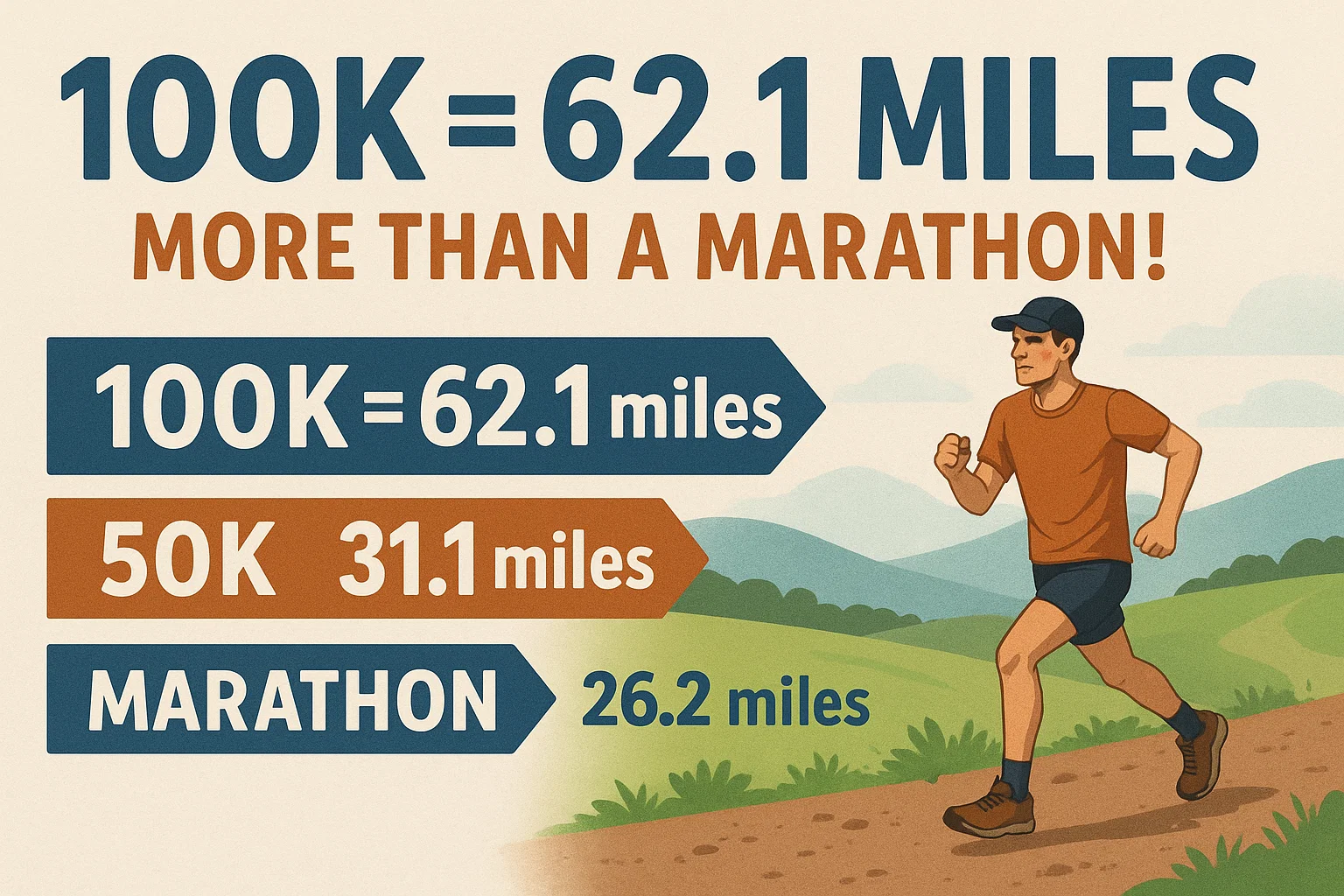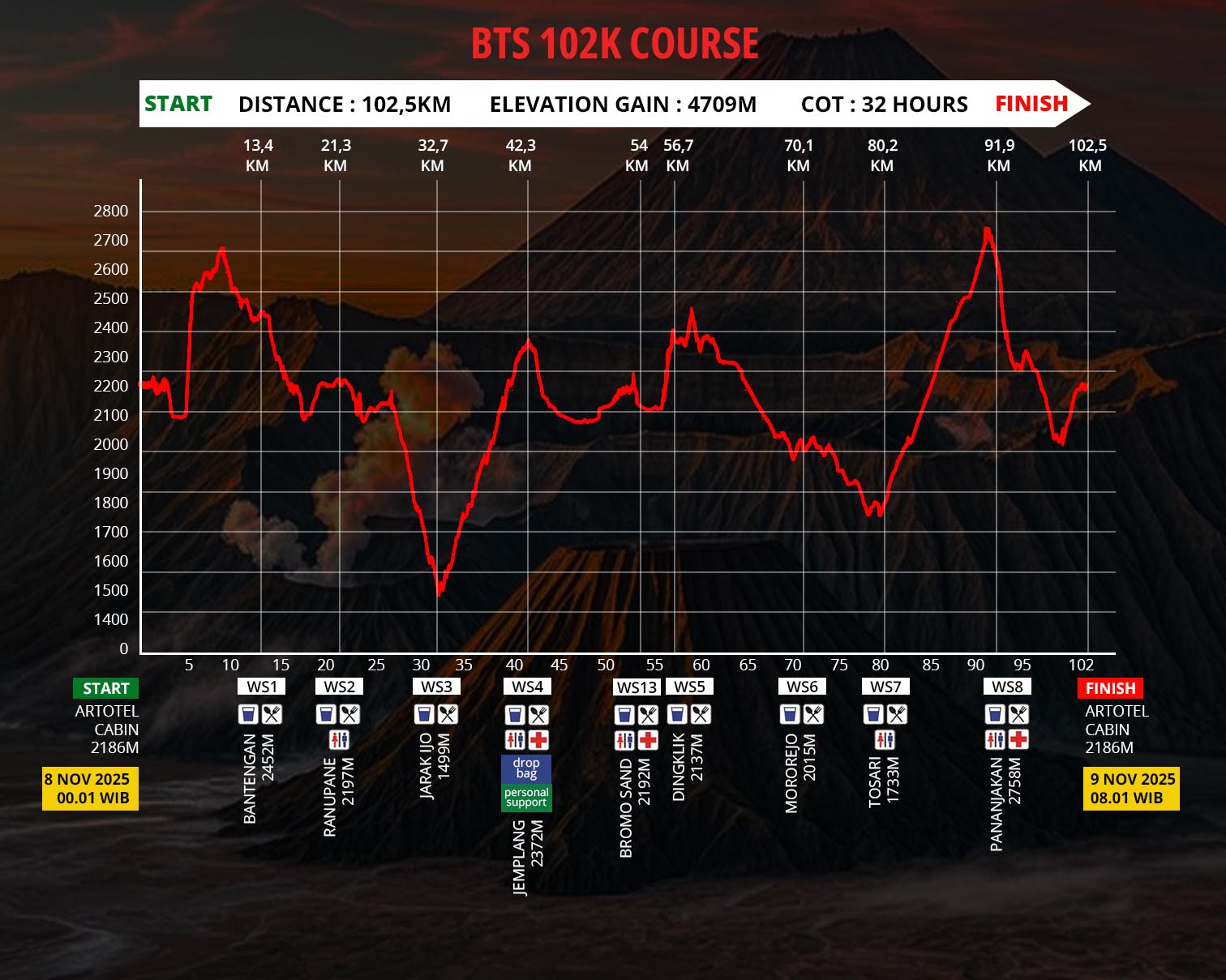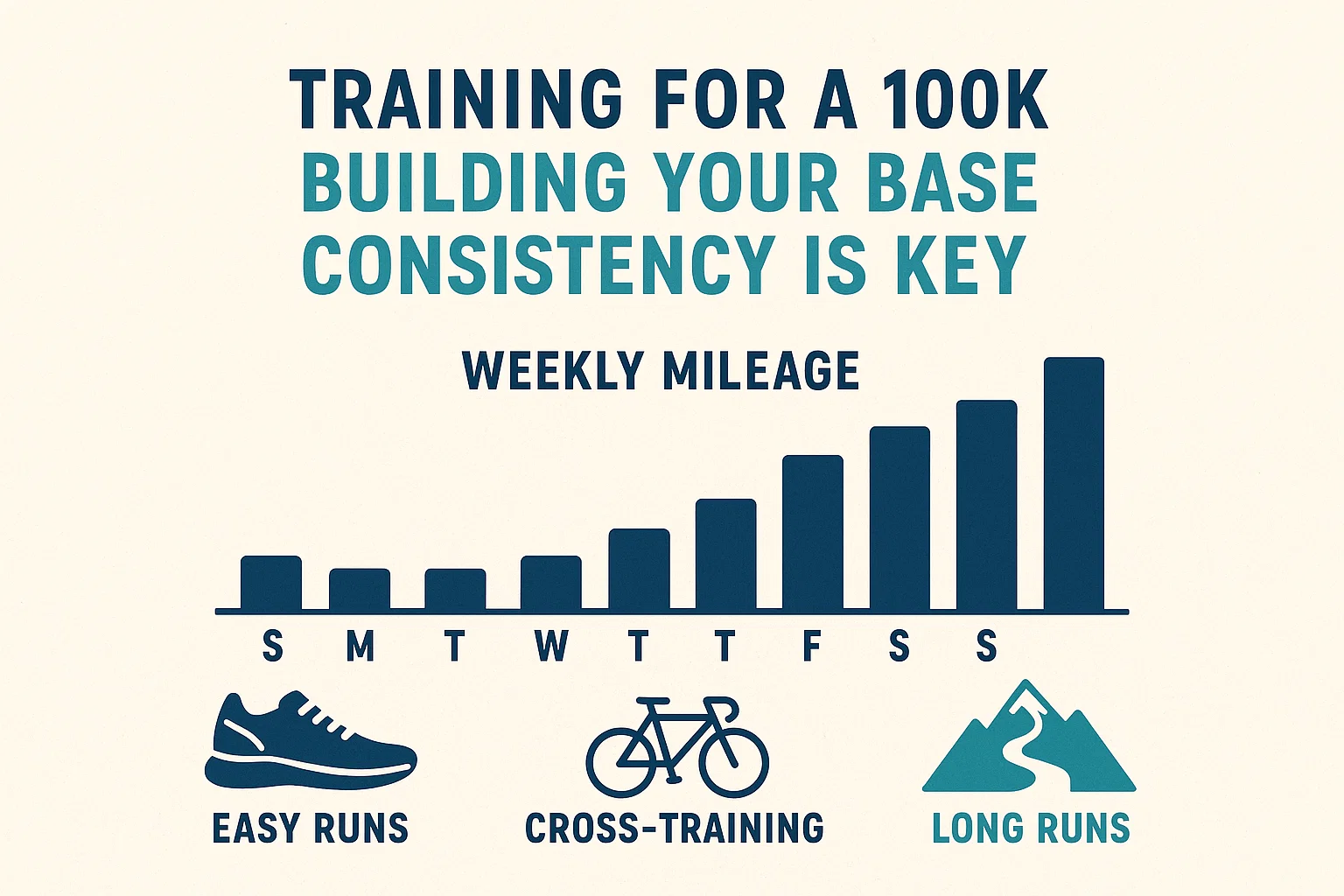So, you’re thinking about running a 100K race.
That’s over 62 miles.
Sounds like a crazy long distance, right?
I mean, imagine running two marathons back-to-back—that’s a 100K. It’s a big challenge, but don’t let that freak you out.
If you’ve done a 50K or a marathon already, this is just the next step. You want to see how far you can push your limits, and honestly, that’s why we do this, right?
Trust me, with the right mindset and some solid training, a 100K can totally be within your reach.
Since I’m planning to run my first 100K this year (BTS 100 in Java), I decided to write a long post about how I’m planning to train for this distance (already ran a few 50Ks and 75Ks) so you can have a rough idea on how to structure your training plan once you also decide to go a 100.
Sounds like a good idea?
Let’s get to it.
So, What Exactly is 100K?
Alright, let’s break it down.
A 100K is 62.1 miles.
Yeah, that’s insane when you put it in perspective.
It’s a whole new ballgame. It’s 49 miles more than a half marathon, 36 miles more than a marathon, and 30 miles more than a 50K. Do the math—that’s like running 20 full 5Ks in a row.
Yeah, twenty.
It doesn’t really hit you until you’re out there, one foot in front of the other, and the miles start stacking up.
At first, it feels like a lot. But once you get into the groove of training, you realize breaking it down into chunks makes it way more manageable.
But don’t get me wrong. Most 100K races aren’t your typical road events. Most ultra events take plan on trails and treacherous terrains so comparing them to road events when it comes to distance alone is not fair.
But don’t worry, I’ll be sharing with how I’m planning to prepare my body for the crazy vertical gains and technical terrain. For reference, BTS ultra 100K is around 4700m of elevation gain with a 32 hours cut-off time. Not the most challenging course, but I know it’s gonna be challenging enough for me as a first-timer.
How Long Does It Take to Run a 100K?
Expect to spend anywhere from 10 to 15 hours on your feet.
And yes, that means running through meals, running through the dark, and covering an entire day of effort.
I’ve never run a 100K before, but I’ve done several 50K and 75K races, so I know it’s no walk in the park.
I’m preparing for my first 100K this December, and just thinking about it is both exciting and a little nerve-wracking.
I can already picture myself asking, “Why did I sign up for this again?” But I know that crossing that finish line after such an epic journey will be unforgettable.
Curious about times? The average 100K time sits at 09:09:35. A super fast time? Anything under six hours. But for most of us, it’s about that steady, “grind it out” pace.
Are You Ready for a 100K?
Let’s be honest—jumping straight into a 100K with zero ultra-distance experience is a bad idea.
Doesn’t matter how strong you think you are. You need time to build up to this kind of distance.
For me, after knocking out several 50K races, I knew that a 100K was the logical next step. But I also knew it would take a whole different kind of training.
Get yourself some ultra-distance races under your belt—50K, 75K. Those will give you the foundation you need.
And when you cross those finish lines, don’t just feel good about finishing. Push yourself to finish strong. Those races will set you up mentally and physically for the 100K.
Get Your Mind Ready Too
Let’s talk mental game.
If you think a 100K is only about your physical strength, you’re missing the point. It’s mostly mental. You could be in great shape, but your mind is going to be your toughest opponent.
I’m mentally prepping for this 100K by reminding myself it’s going to test me like never before.
I expect moments where I’ll question why I’m running for hours. And that’s okay. I’m focusing on the process—taking it one week at a time. I’m not thinking about the whole 100K yet, just the run I’m doing today.
When I ran my first 50K, I hit mental lows where I wanted to quit. But every time, I reminded myself that the finish line was still within reach if I just kept going. It’s about believing you’re capable of more than you think.
Spend Time on Your Feet
You might think long runs are all about speed, but nope, it’s about time on your feet.
When I do my long runs and hikes, I ain’t thinking about speed—I’m only focused on how long I could keep going.
You need to get used to being on your feet for hours, whether you’re running or hiking.
That’s why I’m planning on doing back-to-back long runs and full-day hikes, sometimes lasting 8-12 hours.
That simulates the kind of mental and physical endurance I’ll need for the BTS 100. Getting my body used to being on your feet for long stretches is crucial. These long days have been a big part of my prep for this race.
Fueling Is Key
You can’t get away with half-baked fueling when you’re running a 100K. Unlike a 5K where a few gels might get you through, long-distance running demands a solid nutrition plan.
Without it, you’ll hit the wall way before the halfway point.
Believe me, I’ve learned the hard way. Some nutrition choices had me feeling like a champ, while others left me wishing someone would drive me off the course.
The trick? You’ve got to experiment. Try different foods, hydration plans, and see what works best for your body on those long training days.
Picking Your First 100K
Choosing your first 100K? It’s a big decision.
Don’t dive straight into an insane race right out of the gate. Go for something that’s relatively flat and in a climate that you can handle.
I learned the hard way that a course with steep hills or crazy weather can take you out early. Trust me, you want to pick a race that won’t break you mentally in those first miles.
For your debut 100K, find a race with solid support. Look for aid stations and volunteers who’ve got your back. Sites like UltraSignup are perfect for finding races that match your experience level. Finish your first, and you’ll be ready to tackle the next challenge.
I chose the BTS 100K because (1) I’ve already joined a few races in the same region (think Bromo Desert and Bromo Marathon) so I know what to expect when it comes to trail difficulty, elevation, and weather.
Plus (2), some of my friends have already joined this event as their first 100Ker and have praised it highly for how well it’s organized and relative easiness of the terrain course compared to other ultra events.
Just take a look at the course map and you can tell.
Integrating Vertical Training
In preparation for the elevation changes, I’ve been adding hill workouts into my training plan. Steep climbs and descents are mentally and physically challenging, but the more you train on them, the better you’ll handle them during the race.
I’ve been incorporating hill repeats into my weekly runs, which means sprinting up a hill and then jogging or walking back down to recover. These workouts help build the leg strength you’ll need, especially for descents, which can be surprisingly taxing on the quads. Also, don’t forget about power hiking for those steep climbs—it’s a skill that’ll save you a lot of energy when the terrain gets tough.
If you’re training for a race with significant elevation changes, you’ll want to get used to the terrain in advance.
Train on the kind of surfaces you’ll be racing on.
For me, I’ve been running on rocky trails and sandy paths to simulate the different types of technical terrain I’ll face. The more variety you add to your training, the more prepared you’ll be for race day.
100K Training Plan: Building Endurance and Resilience Step by Step
Training for a 100K isn’t just about running long distances; it’s about smart, steady progress and recovery.
Here’s a breakdown of a 24-week training plan for beginners (like me!) aiming for their first 100K race.
It’ll guide you step by step through base building, endurance, peak training, and tapering.
Beginner 100K Training Plan (24 weeks)
Phase 1: Base Building (Weeks 1-8)
- Mileage: Start with around 25 miles per week, increasing by 10% every two weeks.
- Key Workouts:
- Long Run: Start with 10 miles, building up to 16 miles by Week 8.
- Easy Runs: Two or three runs per week at a relaxed pace. These runs should feel comfortable—no speed involved.
- Cross-Training: One session per week (e.g., cycling or swimming). These are essential for building overall strength without the impact of running.
- Rest Days: Two days per week to allow recovery and prevent injury.
For me, this phase is all about getting the body used to higher volumes of running. I’ll be making sure I’m training pain-free and gradually increasing the load. The idea is to ease into it and avoid pushing too hard too soon.
Phase 2: Building Endurance (Weeks 9-16)
- Mileage: Gradually increase to 30-40 miles per week, with one cutback week every three weeks to avoid overtraining.
- Key Workouts:
- Long Run: Build up to 20-22 miles for your longest runs.
- Back-to-Back Long Runs: Start incorporating these on weekends. For example, I might run 14 miles on Saturday, followed by 10 on Sunday.
- Tempo Runs: One weekly run at a comfortably hard pace, for about 15-20 minutes. This will help improve speed and stamina.
- Cross-Training and Core Work: Two sessions a week to strengthen supporting muscles, which will help avoid injury.
This phase is where I’ll be building resilience for the long haul. My long runs will gradually get longer, and I’ll really start to focus on pacing, nutrition, and hydration.
Phase 3: Peak Training (Weeks 17-22)
- Mileage: Peak at 45-50 miles per week.
- Key Workouts:
- Long Run: Aim for one long run of around 28-30 miles, along with shorter long runs of 15-20 miles.
- Back-to-Back Long Runs: These will continue, ideally on challenging terrain to simulate race conditions.
- Intervals: One weekly session of intervals or hill repeats.
- Cross-Training: Maintain strength and flexibility with yoga, core exercises, or light cycling.
By this stage, I’ll be running my longest distances—this is where the body and mind really start to feel the challenge. It’s also the phase where I’ll focus on mental toughness, making sure I can push through fatigue and get accustomed to the race-day discomfort.
Phase 4: Tapering (Weeks 23-24)
- Reduce mileage to allow your body to recover and prepare.
- Key Workouts: Keep up with shorter, easy runs and one last long effort at about half your peak distance.
By this point, I’ll be cutting back on the mileage to let my body rest and recover while still maintaining a level of fitness. Tapering can be tricky—physically, you feel like you want to keep running, but mentally, you’ll appreciate the extra recovery.
Common 100K Training Questions
I know that you’ve probably got a bunch of questions floating around in your mind right now, so let’s address some of the most common concerns.
What should I eat before a 100K run?
Before a 100K, I’ll be eating a balanced meal that combines complex carbs, lean protein, and healthy fats to fuel my body.
Examples include oatmeal with almond butter and fruit, a quinoa bowl with grilled chicken, or a hearty smoothie. Make sure you eat 3-4 hours before race day to give your body time to digest.
How many miles should I run each week when training for a 100K?
Weekly mileage varies depending on experience. For beginners, like me, you should aim to start around 20-30 miles per week, and gradually build up to a peak of around 45-50 miles. Intermediate runners might start at 35 miles per week, eventually reaching 60-70 miles during peak weeks. But always balance these miles with recovery days to avoid overtraining.
What gear is essential for a 100K ultra marathon?
The right gear is crucial for comfort and performance. I’ll be using a hydration vest or pack, trail shoes (planning to buy a Hoka Speed goat 5) with great traction, moisture-wicking clothing, and blister prevention essentials like anti-chafing balm and high-quality socks. I’ll also make sure to have fueling options like gels, electrolyte tablets, and energy bars at the ready.
So in total you’d need a comfortable hydration vest or pack, trail shoes with good traction, moisture-wicking clothing, and layers if you’re running in varying weather conditions.
How much recovery do I need after a 100K run?
After completing a 100K, I’ll need at least two to three weeks of dedicated recovery. I’ll start with gentle movement like walking or light stretching, then gradually ease back into running. Staying hydrated, getting proper nutrition, and prioritizing sleep will help speed up my recovery.
What Makes a 100K Different?
Training for a 100K isn’t like training for shorter races. It’s all about building staying power. Here’s what you should focus on:
- Mileage Progression: Instead of peaking at a marathon’s 26 miles, you’ll build to 30-35 miles in a single run, with back-to-back long runs becoming part of your routine.
- Fueling Strategy: Your body will need constant fuel to keep you going, so developing a fueling plan is critical.
- Mental Prep: Ultra races demand mental endurance just as much as physical stamina. Visualizing success and maintaining a positive mindset can make all the difference.




Thanks for the training tips! I’ve run a few marathons but never anything longer.
Thanks for this David Dack. Great article
Thank you for this detailed guide! I’ve been eyeing a 100K but wasn’t sure how to train for it. Your focus on long runs and consistent weekly mileage has given me a solid plan to follow
The tips on endurance training and mental preparation were exactly what I needed to start planning my own 100K journey.
I’m ready to take on the challenge now—thank you
Great breakdown!
Your advice on nutrition, hydration, and pacing for a 100K is incredibly helpful—definitely bookmarking this for my training!